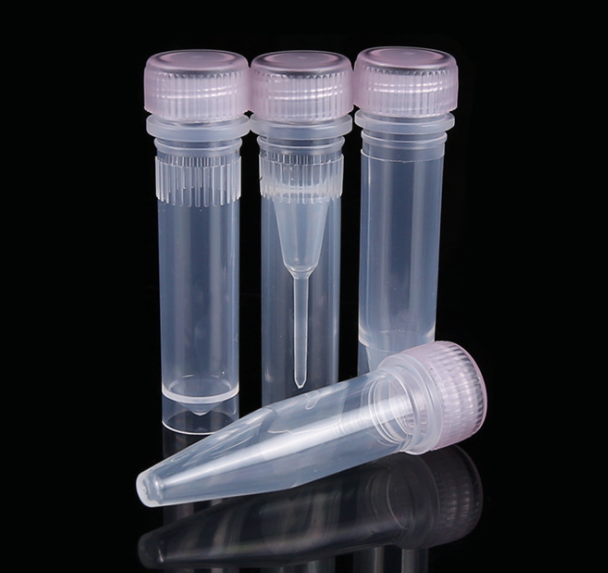Cryovials are commonly used for the cryogenic storage of cell lines and other critical biological materials, in dewars filled with liquid nitrogen.
There are several stages involved in the successful preservation of cells in liquid nitrogen. Whilst the basic principle is a slow freeze, the exact technique employed depends on the cell type and cryoprotectant used. There are several safety considerations and best practices to take into account when storing cells at such low temperatures.
This post aims to give an overview of how cryovials are stored in liquid nitrogen.
What are Cryovials
Cryovials are small, capped vials designed for storing liquid samples at extremely low temperatures. They ensure that cells preserved in cryoprotectant do not come into direct contact with the liquid nitrogen, minimising the risk of cellular fractures whilst still benefiting from the extreme cooling effect of liquid nitrogen.
The vials are usually available in a range of volumes and designs – they can be internally or externally threaded with flat or rounded bottoms. Sterile and non-sterile formats are also available.
Who Uses Cyrovials to Store Cells in Liquid Nitrogen
A range of NHS and private laboratories, as well as research institutions specialising in cord blood banking, epithelial cell biology, immunology and stem cell biology use cryovials to cryopreserve cells.
Cells preserved in this way include B and T Cells, CHO Cells, Hematopoietic Stem and Progenitor Cells, Hybridomas, Intestinal Cells, Macrophages, Mesenchymal Stem and Progenitor Cells, Monocytes, Myeloma, NK Cells and Pluripotent Stem Cells.
Overview of How To Store Cryovials in Liquid Nitrogen
Cryopreservation is a process that preserves cells and other biological constructs by cooling them to very low temperatures. Cells can be stored in liquid nitrogen for years without loss of cell viability. This is an outline of the procedures employed.
Cell Preparation
The exact method for preparing samples will vary depending on the cell type, but in general, the cells are collected and centrifuged to develop a cell-rich pellet. This pellet is then resuspended in the supernatant mixed with cryoprotectant or a cryopreservation medium.
Cryopreservation Medium
This medium is employed to preserve cells in the low-temperature environments they will be subjected to by inhibiting the formation of intra and extracellular crystals and hence cell death. Their role is to provide a safe, protective environment for cells and tissues during the freezing, storage, and thawing processes.
A medium such as fresh frozen plasma (FFP), heparinised plasmalyte solution or serum-free, animal component-free solutions is mixed with cryoprotectants such as dimethyl sulphoxide (DMSO) or glycerol.
The re-liquified sample pellet is aliquoted into polypropylene cryovials such as Suzhou Ace Biomedical company Cryogenic Storage Vials.
It is important not to overfill the cryovials as this will increase the risk of cracking and the possible release of contents (1).
Controlled Freeze Rate
In general, a slow controlled freeze rate is employed for the successful cryopreservation of cells.
After samples are aliquoted into cryogenic vials, they are placed on wet ice or in a 4℃ refrigerator and the freezing procedure is started within 5 minutes. As a general guide, cells are cooled at a rate of -1 to -3 per minute (2). This is achieved using a programmable cooler or by placing vials in an insulated box placed in a –70°C to –90°C controlled rate freezer.
Transfer to Liquid Nitrogen
The frozen cryogenic vials are then transferred to a liquid nitrogen tank for indefinite periods provided a temperature of less than -135℃ is maintained.
These ultra-low temperatures can be obtained by immersion in the liquid or vapour phase nitrogen.
Liquid or Vapour Phase?
Storage in liquid phase nitrogen is known to maintain the cold temperature with absolute consistency, but is often not recommended for the following reasons:
- The need for large volumes (depth) of liquid nitrogen which is a potential hazard. Burns or asphyxiation due to this is a real risk.
- Documented cases of cross-contamination by infectious agents such as aspergillus, hep B and viral spread via the liquid nitrogen medium (2,3)
- The potential for liquid nitrogen to leak into the vials during immersion. When removed from storage and warmed to room temperature, the nitrogen rapidly expands. Consequently, the vial may shatter when removed from liquid nitrogen storage, creating a hazard from both flying debris and exposure to the contents (1, 4).
For these reasons, ultra-low temperature storage is most commonly in vapour phase nitrogen. When samples must be stored in the liquid phase, specialized cryoflex tubing should be used.
The downside to the vapour phase is that a vertical temperature gradient can occur resulting in temperature fluctuations between -135℃ and -190℃. This necessitates careful and diligent monitoring of the liquid nitrogen levels and temperature variations (5).
Many manufacturers recommend that cryovials are suitable for storage down to -135℃ or for use in the vapour phase only.
Thawing Your Cryopreserved Cells
The thawing procedure is stressful for a frozen culture, and proper handling and technique is required to ensure optimal viability, recovery, and functionality of the cells. The exact thawing protocols will depend on specific cell types. However, rapid thawing is considered standard to:
- Decrease any impact on cellular recovery
- Help reduce the exposure time to the solutes present in the freezing media
- Minimise any damage by ice recrystallisation
Water baths, bead baths, or specialized automated instruments are commonly used to thaw samples.
Most frequently 1 cell line is thawed at a time for 1-2 minutes, by gently swirling in a 37℃ water bath until there is just a small bit of ice left in the vial before they are washed in a prewarmed growth medium.
For some cells such as mammalian embryos, slow warming is essential for their survival.
The cells are now ready for cell culture, cell isolation, or in the case of haematopoietic stem cells – viability studies to guarantee the integrity of the donor stem cells before myeloablative therapy.
It is normal practice to take small aliquots of the prewashed sample used to perform a cell count to determine cell concentrations for plating in culture. You can then assess the results of cell isolation procedures and determine cell viability.
Best Practices for the Storage of Cryovials
The successful cryopreservation of samples stored in cryovials depends on many elements in the protocol including proper storage and record keeping.
- Split cells between storage locations – If volumes allow, split cells between vials and store them in separate locations to reduce the risk of sample loss due to equipment failures.
- Prevent cross-contamination – Opt for single-use sterile cryogenic vials or autoclave before subsequent use
- Use appropriately sized vials for your cells – vials come in a range of volumes between 1 and 5mls. Avoid overfilling vials to reduce the risk of cracking.
- Select internal or externally threaded cryogenic vials – Internally threaded vials are recommended by some universities for safety measures – they can also prevent contamination during filling or when stored in the liquid nitrogen.
- Prevent Leakage - Use bi-injected seals moulded into the screw-cap or O-rings to prevent leaking and contamination.
- Use 2D barcodes and label vials – to ensure traceability, vials with large writing areas enable each vial to be adequate labelled. 2D barcodes can help with storage management and record keeping. Colour coded caps are useful for easier identification.
- Adequate storage maintenance - To ensure cells are not lost, storage vessels should constantly monitor the temperature and liquid nitrogen levels. Alarms should be fitted to alert users of errors.
Safety Precautions
Liquid nitrogen has become common practice in modern research but carries the risk of serious injury if used incorrectly.
Proper personal protective equipment (PPE) should be worn to minimize the risk of frostbite, burns and other adverse incidents when handling liquid nitrogen. Wear
- Cryogenic gloves
- Laboratory coat
- Impact resistant full face shield that also covers the neck
- Closed-toe shoes
- Splashproof plastic apron
Liquid nitrogen refrigerators should be placed in well-ventilated areas to minimize the risk of asphyxiation – escaped nitrogen vaporizes and displaces atmospheric oxygen. Large volume stores should have low oxygen alarm systems.
Working in pairs when handling liquid nitrogen is ideal and its use outside of normal working hours should be prohibited.
Cryovials to Support Your Workflow
Suzhou Ace Biomedical company offers a wide selection of products that meet your cryopreservation needs for different types of cells. The portfolio includes a range of tubesas well as a range of sterile cryovials.
Our cryovials are:
-
Lab Screw Cap 0.5mL 1.5mL 2.0mL Cryovial Cryogenic Vials Conical Bottom Cryotube with Gasket
● 0.5ml,1.5ml,2.0ml specification,with skirt or without skirt
● Conical or self standing design, sterile or non-sterile are both available
● Screw cap tubes are made of medical grade polypropylene
● PP Cryotube Vials can be repeatedly frozen and thawed
●The external cap design can reduce the contamination probability during sample treatment.
● Screw cap cryogenic tubes Universal screw threads for use
● Tubes fit most common rotors
● Cryogenic tube o-ring tubes fit standard 1-inch and 2-inch, 48well, 81well,96well and 100well freezer boxes
● Autoclavable to 121°C and freezable to -86°CPART NO
MATERIAL
VOLUME
CAP COLOR
PCS/BAG
BAGS/CASE
ACT05-BL-N
PP
0.5ML
Black,Yellow,Blue,Red,Purple,White
500
10
ACT15-BL-N
PP
1.5ML
Black,Yellow,Blue,Red,Purple,White
500
10
ACT15-BL-NW
PP
1.5ML
Black,Yellow,Blue,Red,Purple,White
500
10
ACT20-BL-N
PP
2.0ML
Black,Yellow,Blue,Red,Purple,White
500
10
Post time: Dec-27-2022


